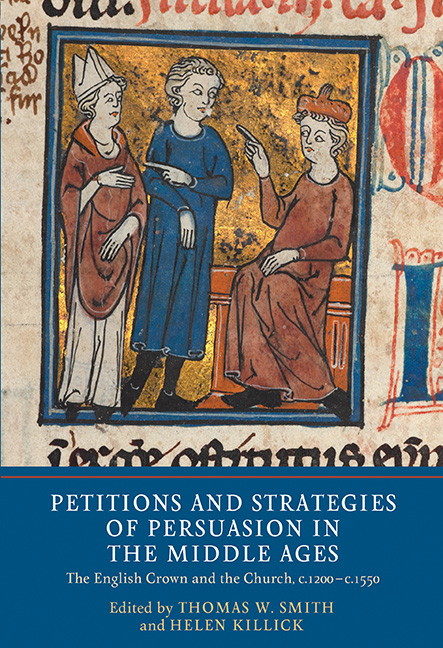 Petitions and Strategies of Persuasion in the Middle Ages
Petitions and Strategies of Persuasion in the Middle Ages Book contents
- Frontmatter
- Dedication
- Contents
- Contributors
- Foreword
- Acknowledgements
- List of Abbreviations
- Introduction: Medieval Petitions and Strategies of Persuasion
- 1 Blood, Brains and Bay-Windows: The Use of English in Fifteenth- Century Parliamentary Petitions
- 2 Petitioners for Royal Pardon in Fourteenth-Century England
- 3 The Scribes of Petitions in Late Medieval England
- 4 Patterns of Supplication and Litigation Strategies: Petitioning the Crown in the Fourteenth Century
- 5 Petitions of Conflict: The Bishop of Durham and Forfeitures of War, 1317–1333
- 6 A Tale of Two Abbots: Petitions for the Recovery of Churches in England by the Abbots of Jedburgh and Arbroath in 1328
- 7 ‘By Force and Arms’: Lay Invasion, the Writ de vi laica amovenda and Tensions of State and Church in the Thirteenth and Fourteenth Centuries
- 8 The Papacy, Petitioners and Benefices in Thirteenth-Century England
- 9 Playing the System: Marriage Litigation in the Fourteenth Century
- 10 Killer Clergy: How did Clerics Justify Homicide in Petitions to the Apostolic Penitentiary in the Late Middle Ages?
- Index
4 - Patterns of Supplication and Litigation Strategies: Petitioning the Crown in the Fourteenth Century
Published online by Cambridge University Press: 20 August 2020
- Frontmatter
- Dedication
- Contents
- Contributors
- Foreword
- Acknowledgements
- List of Abbreviations
- Introduction: Medieval Petitions and Strategies of Persuasion
- 1 Blood, Brains and Bay-Windows: The Use of English in Fifteenth- Century Parliamentary Petitions
- 2 Petitioners for Royal Pardon in Fourteenth-Century England
- 3 The Scribes of Petitions in Late Medieval England
- 4 Patterns of Supplication and Litigation Strategies: Petitioning the Crown in the Fourteenth Century
- 5 Petitions of Conflict: The Bishop of Durham and Forfeitures of War, 1317–1333
- 6 A Tale of Two Abbots: Petitions for the Recovery of Churches in England by the Abbots of Jedburgh and Arbroath in 1328
- 7 ‘By Force and Arms’: Lay Invasion, the Writ de vi laica amovenda and Tensions of State and Church in the Thirteenth and Fourteenth Centuries
- 8 The Papacy, Petitioners and Benefices in Thirteenth-Century England
- 9 Playing the System: Marriage Litigation in the Fourteenth Century
- 10 Killer Clergy: How did Clerics Justify Homicide in Petitions to the Apostolic Penitentiary in the Late Middle Ages?
- Index
Summary
Petitioning the crown as an individual involved seeking to gain the attention of the king either through an oral supplication recorded by the parliamentary clerks or via a document containing the request for grace submitted to the clerks in the petitioner's absence. Unless the petition was ‘fast-tracked’ and read out to the king and his council during a parliamentary session, it was delegated to a committee of ‘auditors and triers’ comprising members of the nobility, senior churchmen and legal experts. Some were responded to immediately, others were diverted to officials in particular branches of government (including the exchequer, chancery and the courts of king's bench and common pleas). While it appears from the instructions and comments endorsed on surviving petitions that it was a somewhat administrative means of achieving justice, it was not a purely bureaucratic process. Applications were read out to the panel, who, upon hearing it, discussed the merits and made their decision accordingly or sought advice from other departments.
The supplicant made his or her submission trusting that a favourable response would be achieved. Much depended, however, upon the way the petition was framed and the language used in formulating it. In order to present the subject matter of the complaint and concomitant request for remedy in a suitably persuasive manner, the petitioner needed to employ not only an overarching narrative but also convincing legal arguments and a range of rhetorical devices. Petitions were thus inevitably ‘artful constructs designed to get something done’. This is an area in which ‘a good deal of work remains to be done’, as Mark Ormrod acknowledged, notably ‘on the way in which words, phrase and forms were chosen by the writers of petitions to create effect and impact’. Answering the call, this paper assesses changing patterns of supplication and corresponding litigation strategies adopted by medieval petitioners, exploring especially their discourses and linguistic approaches. In order to analyse and contextualise this multipurpose form, I will draw upon petitions presented to the king by a variety of supplicants, though with special focus on manorial tenants and litigants in the court of Chivalry. In particular, I will examine the mentalities and logistics involved, the advantages in terms of procedure and the concerns of litigants (the matters at stake and the corresponding legal issues raised), as well as the tactics and manoeuvres employed in pursuit of strategic aims.
- Type
- Chapter
- Information
- Petitions and Strategies of Persuasion in the Middle AgesThe English Crown and the Church, c.1200–c.1550, pp. 88 - 109Publisher: Boydell & BrewerPrint publication year: 2018


